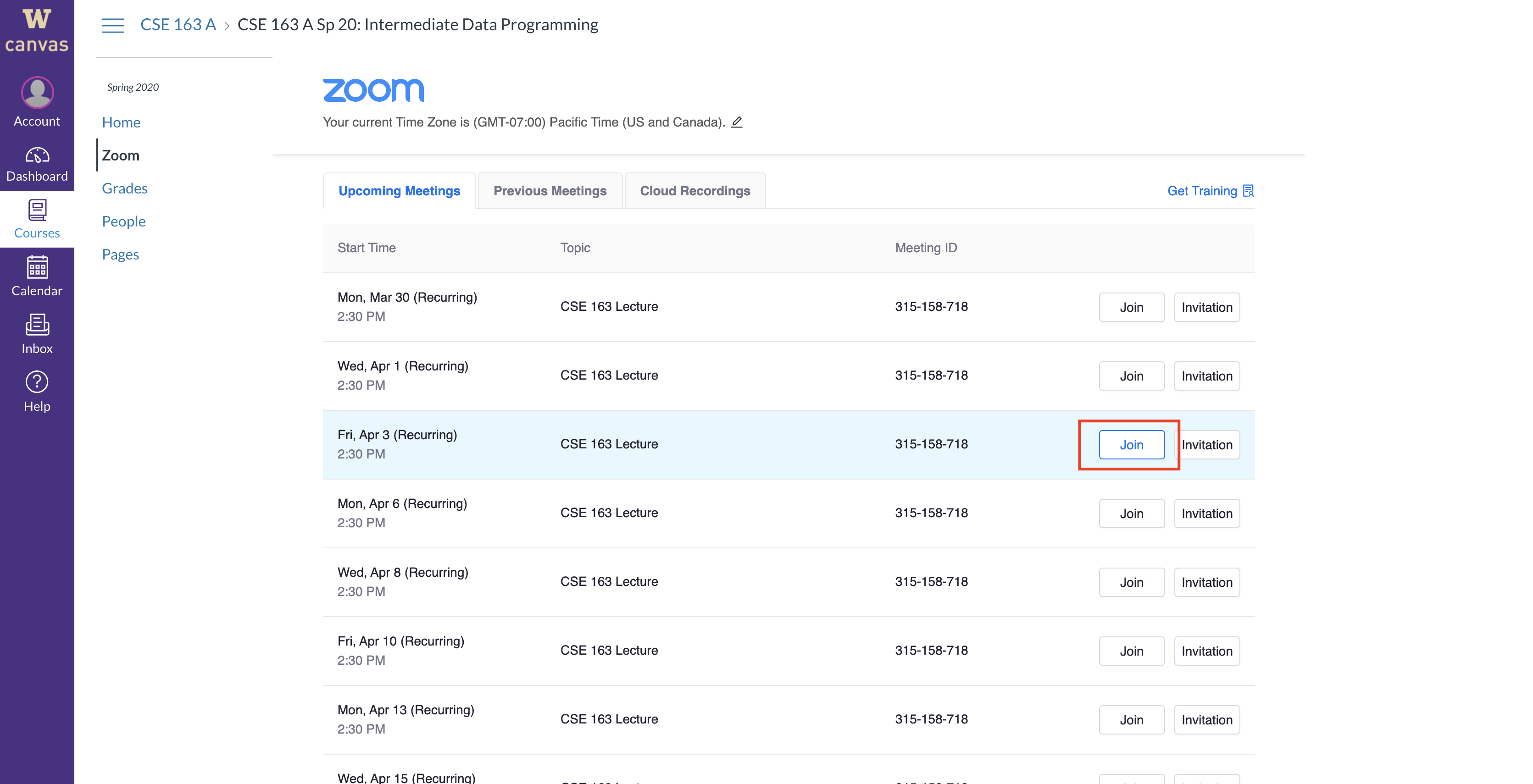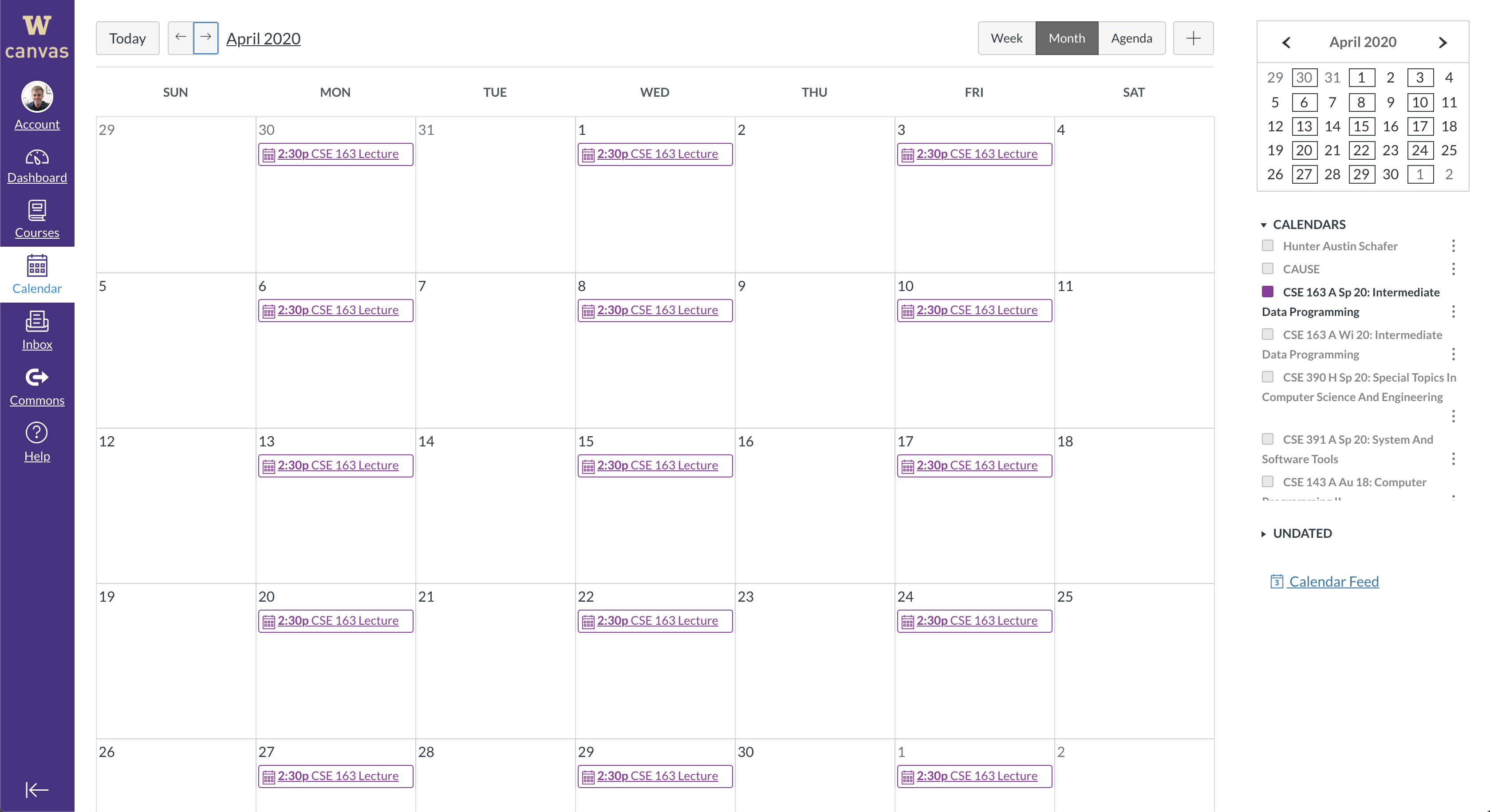CSE 142, Autumn 2020: Zoom Instructions
Accessing a Zoom Event
There are three main ways to access a Zoom event for CSE 142 described in the sections below. Choose whichever you find most convenient! To access recordings of the lecture sessions, you will need to use the Zoom in Canvas option.
When joining the call, if this is for a class session, you will automatically be added to the call assuming that the member of the course staff leading that session has started the call. If this is for office hours, you may be added to a waiting room and a course staff member will help you when they are available!
For further instructions, see UW-IT's documentation:
- Sign into Zoom software on your computer
- Important: You will need to follow the instructions to "Login with SSO" so you can sign in with your UW Zoom account. For privacy reasons, only UW Zoom accounts will be allowed into our sessions.
- UW Zoom FAQ
Ed Links
In Ed, click on the down arrow icon to navigate to the Resources page.

You can scroll through all available resources, or you can use the search bar to search by instructor or TA name, class time, or lecture or section identifier (e.g. "AA" or "B").

Zoom in Canvas
Click on the Zoom link on the left side of our Canvas course (or this link here). This brings up a list of all Zoom meetings for this course (you will see more meetings since there will also be ones for office hours and sections).

Say you want to join lecture on Friday, April 3. You will click on the "Join" button for lecture that day (shown in the image below), and it will launch a new tab that will launch Zoom. Note that your calendar will likely have more than one event per day (for office hours), so make sure you click the right event! This will then launch Zoom so you can join the meeting (or launch the Zoom app if you have downloaded that).

Canvas Calendar
Access your Canvas calendar by clicking on the Calendar option in the left-most side bar (or accessing this link here). The image below shows you what the Canvas calendar looks like. Make sure in the Calendars section on the right that you have CSE 142 selected, otherwise none of our events will show up. Your calendar likely has more events (including sections and office hours for this course).
You can switch between Week/Month/Agenda on the top right if there are too many events in the month view. You can also use the controls at the top to switch days.

Say you want to join lecture on Friday, April 3. You will click on the event called "CSE 142 Lecture" in the calendar for that day, and then click "Click here to join Zoom Meeting: ..." shown in the picture below. Note that your calendar will likely have more than one event per day (for office hours), so make sure you click the right event! This will then launch Zoom so you can join the meeting (or launch the Zoom app if you have downloaded that).

Accessing Lecture Recordings
To access recordings of the lecture sessions, you will need to use the Zoom in Canvas option. Navigate to Zoom in Canvas (using the instructions above) and then click on the "Cloud Recording" tab (red rectangle in picture below). The click on the link for a lecture on a particular date (red oval in picture below) to launch the web player for the recording.

There will be no recordings of quiz sections or office hours. The university recommends that these events should not be recorded for student privacy reasons since they are not recorded in a regular quarter.
CSE 142 Zoom Norms and Best Practices
- If you are new to Zoom, we highly recommend starting your own call and/or joining a test meeting prior to class to get familiar with the interface!
- Be respectful of one another and the course staff! Your behavior in a Zoom call should match how you would behave if the same event were being held in person. Especially in these uncertain times, it is important to be kind and considerate.
- Choose an appropriate space for joining a Zoom call. To the best of your ability, join class from a place where you can focus
and won't be disturbed. If this is not feasible, try to use headphones to block out some noise around you and if possible use a headset
with a microphone to avoid picking up as much noise around you as possible.
- If you live with others, try to coordinate with them to minimize noise and other internet access during an important Zoom call to keep your area quiet and save bandwidth.
- Think carefully about how your written messages come off in terms of tone. When writing out messages in a chat, it's often convenient to make your messages short. However, short messages can sometimes come off as having an angry or dissatisfied tone, so think carefully about how someone else might interpret the message you send!
- Minimize background distractions for you and others. Think about both the noise and the visuals in your space. Some examples:
- While you are not talking or sharing during a meeting, you should have your audio muted. You should get into the practice of muting/unmuting yourself as appropriate to avoid audio-feedback (and to signal to others that you are trying to say something).
- If you are sharing your video, try to make sure your background is not distracting. If possible, set up your camera so your background is a wall or other simple backdrop.
- Would you chew on cereal next to my ear while we were talking in my office hours? I would hope not! Mute your mic if you are chewing on food or making other noise, or if possible, save the meal for after class.
- Know when it is your turn to speak. It can be hard to keep track of who is speaking and to hear people over each other
in a Zoom call. Pay attention to these norms:
- During large group meetings (i.e. not in a breakout or in a small group) you should not turn on your microphone and speak unless called on. You can use the raise hand feature in Zoom, in the Participants view (see below), to indicate that you would like to speak, or you can use one of the other established communication channels.
- In small group meetings (mostly using Zoom's Breakout Rooms), you should start by unmuting your microphone, turning on
your video (if possible), and introducing yourself to your group mates. If using video and/or audio is not possible, introduce yourself in
the chat. If you are working on a problem in your small group, it is best to decide on one person to share their screen to pull up the
problem so everyone can look at it together.
- When someone shares a screen in Zoom, it will make the Zoom app on your computer go into full screen mode. You can always press the Escape key on your computer to get Zoom to go back into windowed mode.
- You are also welcome to use the non-verbal icons ("yes", "go slower", etc.) or the reactions that Zoom provides. These can be harder to spot while presenting, but we will pause to look for raised hands or other reactions frequently.

